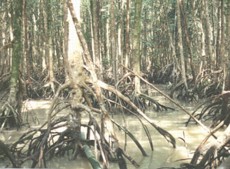- Compiled by Dr.Susan Sharma
Wetlands
Wetlands are among the world's most productive environments. They are cradles of biological diversity, providing the water and primary productivity upon which countless species of plants and animals depend for survival. Wetlands are
an important environmental resource under threat – it is estimated that half the world's wetlands were lost in the 20th century. Wetlands cover 6% of the Earth's surface and range from vast estuaries to small mountain bogs.
Mangroves
Mangroves are tidal forests that grow between the low and high tide marks in many tropical and sub-tropical areas. Mangroves are adapted to unstable mud conditions and continual tidal flooding. The picture on the right shows breathing
roots of a mangrove tree.
 A century ago, the lowlands of north-east India and north-east Bangladesh were covered by shallow wetlands, seasonally flooded grasslands and swamp forest, but large areas have now been drained and converted to cultivation and pasture.
The plains of Assam have been intensively developed, but there are still some extensive natural wetlands there. Habitat loss has been more severe in West Bengal and northern Bangladesh , where only a few fragments ofwetland
remain. Many of the surviving wetlands are included in the region's extensive network of protected areas, some of which are very large, having been established for the protection of Indian rhinoceros and other large mammals.
A century ago, the lowlands of north-east India and north-east Bangladesh were covered by shallow wetlands, seasonally flooded grasslands and swamp forest, but large areas have now been drained and converted to cultivation and pasture.
The plains of Assam have been intensively developed, but there are still some extensive natural wetlands there. Habitat loss has been more severe in West Bengal and northern Bangladesh , where only a few fragments ofwetland
remain. Many of the surviving wetlands are included in the region's extensive network of protected areas, some of which are very large, having been established for the protection of Indian rhinoceros and other large mammals.
India has a rich variety of wetland habitats, covering 18.4 % of its area. 70% of the wetlands is under paddy cultivation. Two wetland sites - Chilka Lake (Orissa) and Keoladeo National Park (Bharatpur) - have been designated under the
Convention of Wetlands of International Importance (Ramsar Convention) as being especially significant waterfowl habitats. The beautiful and charismatic cranes provide the incentive to conserve wetlands and grasslands upon which many other less charismatic
but equally important species also depend.
Many wetlands are shallow and particularly susceptible to being drained and converted for pasture or cultivation. Throughout much of the Brahmaputra valley and Bangladesh local people have cut canals to drain water from small wetlands,
substantially reducing water bird habitats. Similarly, irrigation projects divert water from rivers in the dry season, thus reducing the inflow to wetlands.
People misuse wetlands for intensive farming, overuse fertilizers, waste fresh water and pollute many rivers that flow into wetlands. Some farmers fish and shrimp in wetlands using damaging methods like blasting with dynamite, or using
devices to electrocute fish.
The threat posed to wetlands by the growing number of large dams being built and the intensification of unsustainable agricultural and cattle-raising systems are continuing. So is the threat posed by invasive species of plants.
Wetlands & mangroves are very valuable in many ways:
- as groundwater recharge areas that filter rain and surface water into underlying aquifers
- flood control by acting as natural water retention system during rain events
- filter and denature environmental pollutants (pesticides, heavy metals, and chemicals, especially nitrogen and phosphorous), and
- provide excellent wildlife habitat corridors
- mangroves act as sinks which concentrate pollutants like sewage, toxic minerals and pesticides and herbicides
 The IUCN has categorized India as one of the Asian countries needing more comprehensive national wetland inventory than is presently available, because a vast number of unclassified wetlands are facing conservation crisis. The Satellite
Data maps convey the spatial extent of the wetlands but do not give any information about the exact nature of Fauna and Flora and water quality. Thus these maps are not sufficient to assign conservation values to the wetlands. Wetlands were also not taken
into consideration while planning the protected area network for wildlife in India . Thus there is a strong need to classify wetlands according to their biological components for conservation needs
The IUCN has categorized India as one of the Asian countries needing more comprehensive national wetland inventory than is presently available, because a vast number of unclassified wetlands are facing conservation crisis. The Satellite
Data maps convey the spatial extent of the wetlands but do not give any information about the exact nature of Fauna and Flora and water quality. Thus these maps are not sufficient to assign conservation values to the wetlands. Wetlands were also not taken
into consideration while planning the protected area network for wildlife in India . Thus there is a strong need to classify wetlands according to their biological components for conservation needs
( Picture shows the petals of “Samudra phool” which grows on trees on the Marne Drive , Mumbai.)
P.S
The Convention on Wetlands (Ramsar, Iran, 1971)
The '
Convention on Wetlands' is an intergovernmental treaty for the protection and wise management of wetlands and their resources.